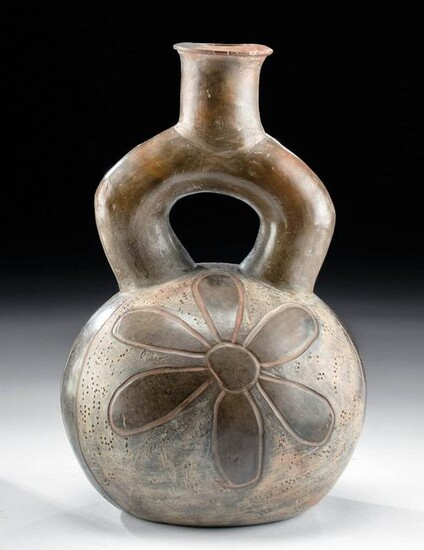Chavin Incised Pottery Stirrup Vessel
**Originally Listed At $1200**
Pre-Columbian, North Coast Peru, Chavin, North Coast Peru, Casa Grande, ca. 1200 to 1000 BCE. A charming example of a hand-built greyware stirrup vessel, the elegant form presenting with a voluminous rounded body sitting upon a planar base, an ample stirrup handle, and a cylindrical spout with a well-defined flared lip. The lustrous surface of the vessel is incised with a lovely pair of flowers, each with six petals and surrounded by a coat of beige-hued paint. A series of incised dots adorns the beige area around the flowers, creating textured accents to the overall design. Size: 6.25" W x 10" H (15.9 cm x 25.4 cm)
The Chavin people lived in the northern Highland Andes, and their capital, Chavin de Huantar, is a UNESCO World Heritage Site. The artwork of Chavin represents the first widespread artistic style in the Andes. The center of Chavin de Huantar is a massive, flat-topped pyramid, surrounded by lower platforms. Between 1200 and 500 BCE the pyramid space was used for religious ceremonies. The Old Temple, constructed very early in the history of the site, consists of a series of passageways built around a circular courtyard; within were carved stone monuments showing jaguars, serpents, and other figures with transformative and/or anthropomorphic figures
The stirrup vessel is named for the stirrups of horseback riding. In addition to being attractive, these vessels were also practical. Their narrow openings prevented rapid evaporation of the precious liquid stored within - a great advantage given the extremely dry deserts of Peru. Note also that the shape of the neck made it easy to carry. Two stirrup vessels could be tied to the ends of a cord and suspended over a llama's back or a person's shoulder.
Provenance: private Hawaii, USA collection; ex-private Hans Juergen Westermann collection, Germany, acquired from 1950 to 1960s
All items legal to buy/sell under U.S. Statute covering cultural patrimony Code 2600, CHAPTER 14, and are guaranteed to be as described or your money back.
A Certificate of Authenticity will accompany all winning bids.
PLEASE NOTE: Due to recent increases of shipments being seized by Australian & German customs (even for items with pre-UNESCO provenance), we will no longer ship most antiquities and ancient Chinese art to Australia & Germany. For categories of items that are acceptable to ship to Australia or Germany, please contact us directly or work with your local customs brokerage firm.
Display stands not described as included/custom in the item description are for photography purposes only and will not be included with the item upon shipping.
#161482
Condition Report: Repaired from several pieces with restoration over break lines. Rim restored from new material. A few miniscule nicks and light scratches, commensurate with age. Otherwise, excellent with impressive pigments.
View it on
Estimate
Time, Location
Auction House
**Originally Listed At $1200**
Pre-Columbian, North Coast Peru, Chavin, North Coast Peru, Casa Grande, ca. 1200 to 1000 BCE. A charming example of a hand-built greyware stirrup vessel, the elegant form presenting with a voluminous rounded body sitting upon a planar base, an ample stirrup handle, and a cylindrical spout with a well-defined flared lip. The lustrous surface of the vessel is incised with a lovely pair of flowers, each with six petals and surrounded by a coat of beige-hued paint. A series of incised dots adorns the beige area around the flowers, creating textured accents to the overall design. Size: 6.25" W x 10" H (15.9 cm x 25.4 cm)
The Chavin people lived in the northern Highland Andes, and their capital, Chavin de Huantar, is a UNESCO World Heritage Site. The artwork of Chavin represents the first widespread artistic style in the Andes. The center of Chavin de Huantar is a massive, flat-topped pyramid, surrounded by lower platforms. Between 1200 and 500 BCE the pyramid space was used for religious ceremonies. The Old Temple, constructed very early in the history of the site, consists of a series of passageways built around a circular courtyard; within were carved stone monuments showing jaguars, serpents, and other figures with transformative and/or anthropomorphic figures
The stirrup vessel is named for the stirrups of horseback riding. In addition to being attractive, these vessels were also practical. Their narrow openings prevented rapid evaporation of the precious liquid stored within - a great advantage given the extremely dry deserts of Peru. Note also that the shape of the neck made it easy to carry. Two stirrup vessels could be tied to the ends of a cord and suspended over a llama's back or a person's shoulder.
Provenance: private Hawaii, USA collection; ex-private Hans Juergen Westermann collection, Germany, acquired from 1950 to 1960s
All items legal to buy/sell under U.S. Statute covering cultural patrimony Code 2600, CHAPTER 14, and are guaranteed to be as described or your money back.
A Certificate of Authenticity will accompany all winning bids.
PLEASE NOTE: Due to recent increases of shipments being seized by Australian & German customs (even for items with pre-UNESCO provenance), we will no longer ship most antiquities and ancient Chinese art to Australia & Germany. For categories of items that are acceptable to ship to Australia or Germany, please contact us directly or work with your local customs brokerage firm.
Display stands not described as included/custom in the item description are for photography purposes only and will not be included with the item upon shipping.
#161482
Condition Report: Repaired from several pieces with restoration over break lines. Rim restored from new material. A few miniscule nicks and light scratches, commensurate with age. Otherwise, excellent with impressive pigments.



